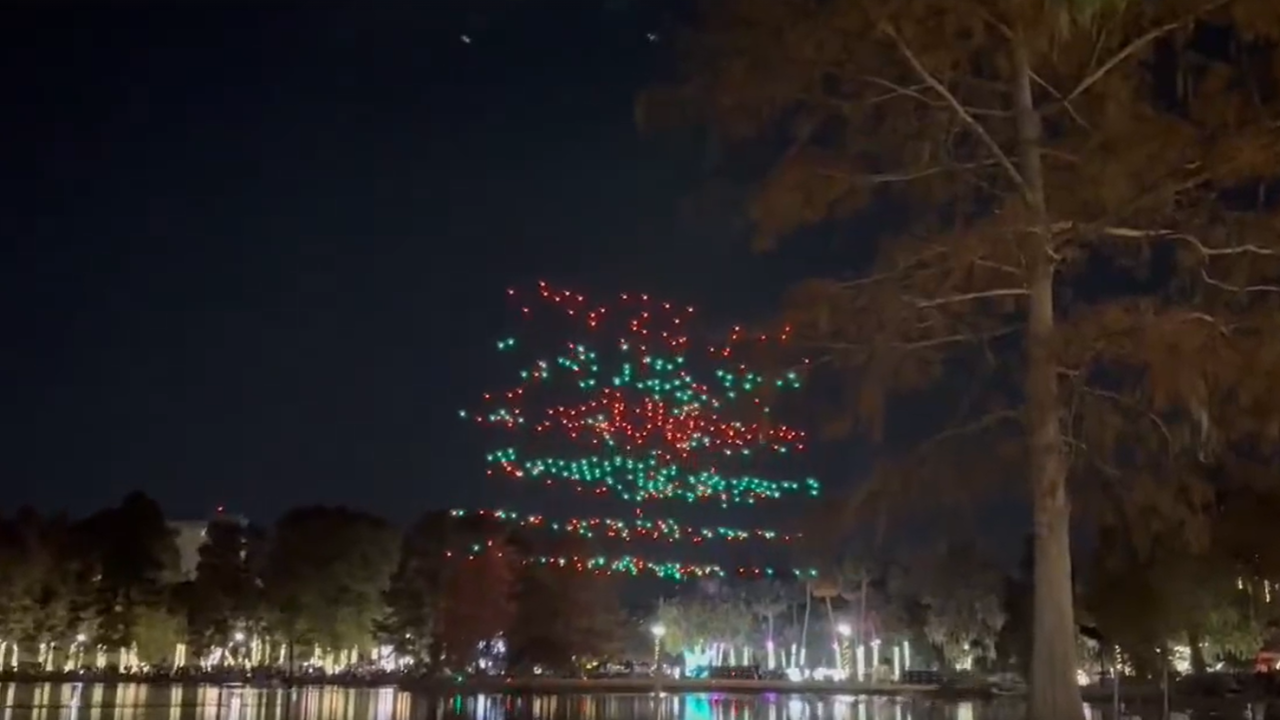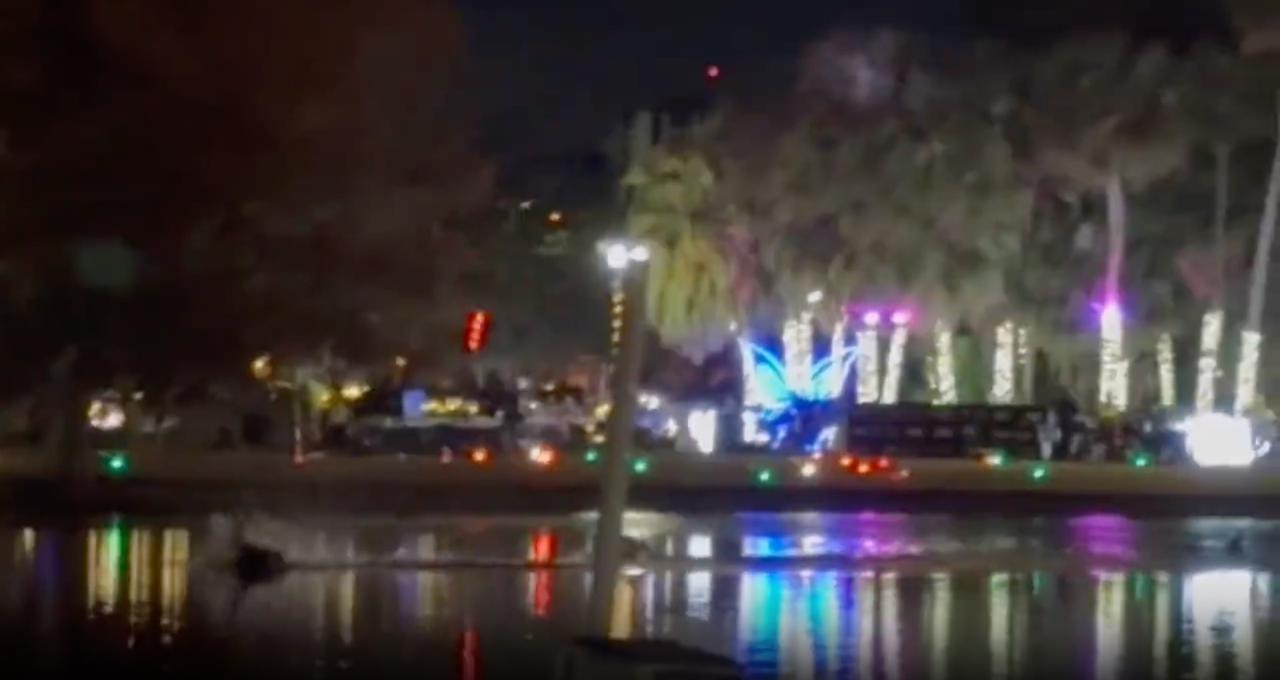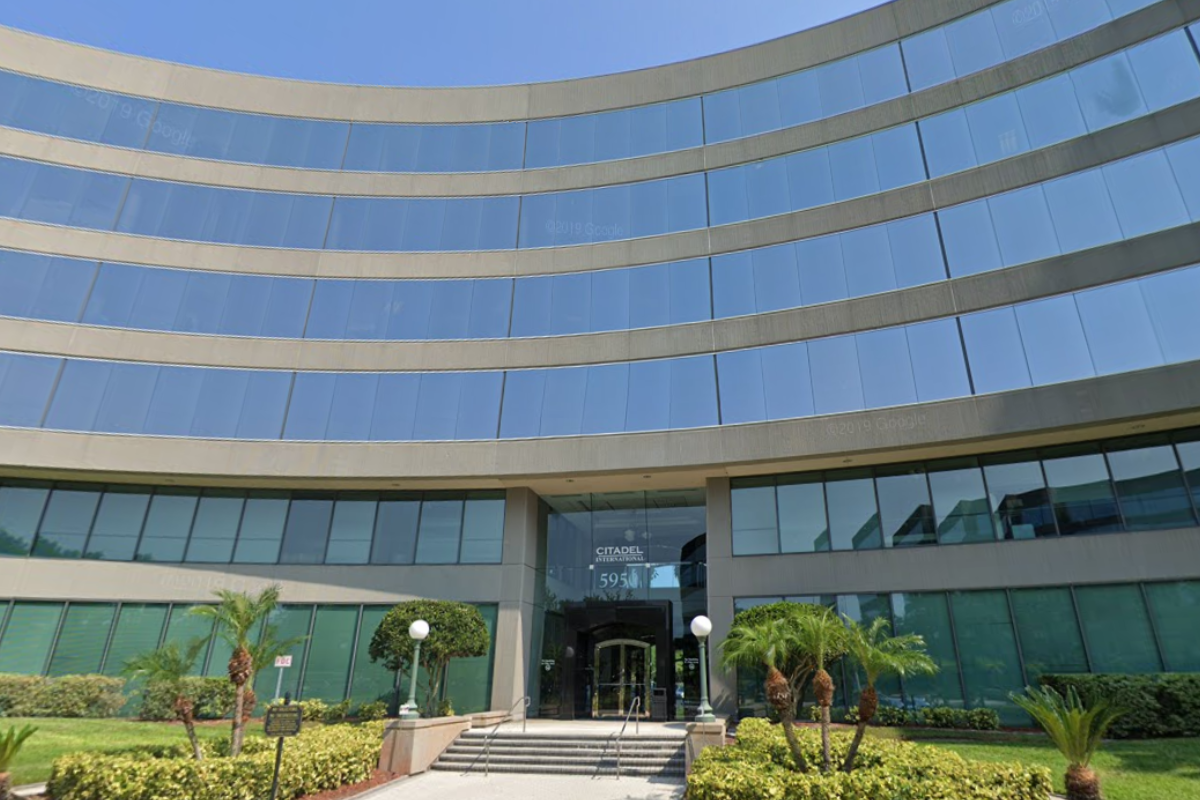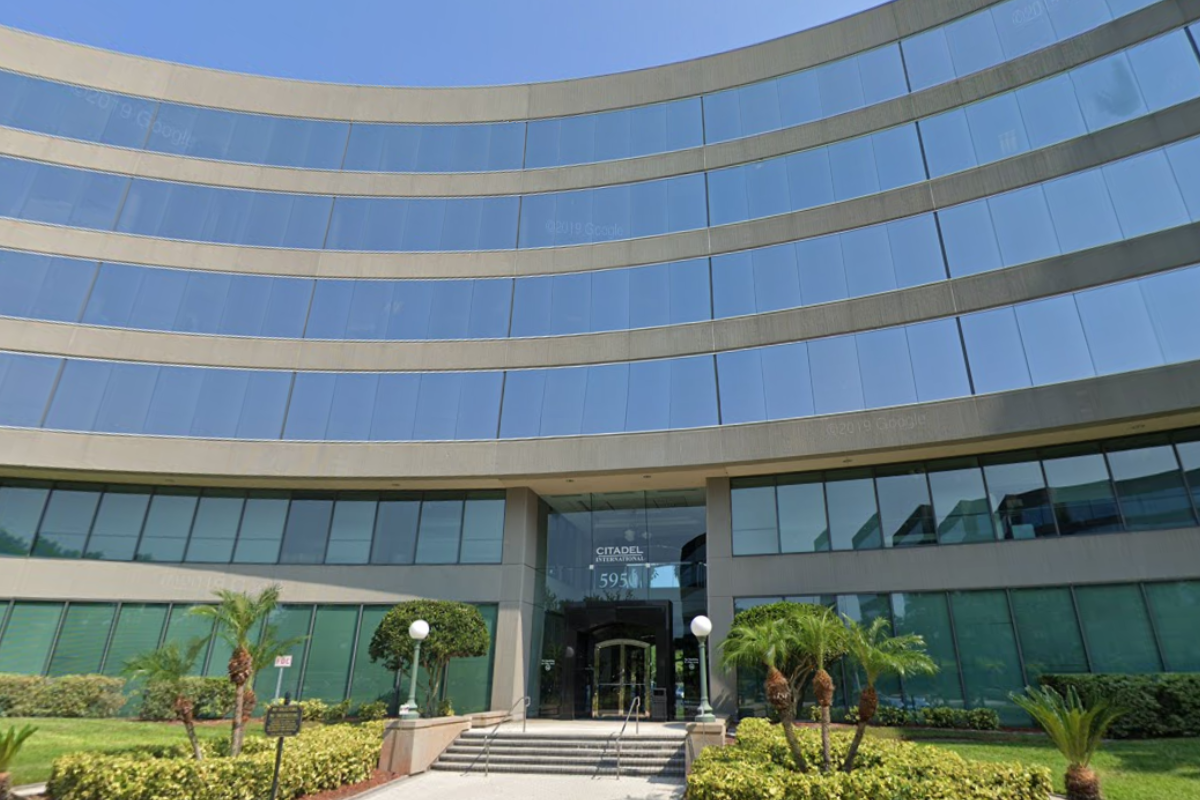Orlando drone show accident: A spectacular aerial display turned unexpectedly tragic. This article delves into the details surrounding this incident, exploring the contributing factors, safety protocols, and the implications for the future of drone shows. We’ll examine everything from technical malfunctions to human error, and discuss how this event shapes the conversation around drone safety and regulations.
We’ll unpack the sequence of events, analyze the drone technology involved, and assess the response from authorities and the public. Our goal is to provide a comprehensive understanding of what happened, why it happened, and what steps can be taken to prevent similar incidents.
Accident Details
The Orlando drone show accident, while thankfully resulting in no serious injuries, highlighted the potential risks associated with large-scale drone displays. This section details the circumstances surrounding the incident, providing a factual account of the events.
The accident involved a malfunction during a nighttime drone show, causing several drones to deviate from their programmed flight paths and collide. While the exact cause is still under investigation, initial reports suggest a possible combination of technical glitches and potentially unfavorable weather conditions played a role.
Drone Specifications and Types
The show utilized a fleet of approximately 500 commercially available quadcopter drones, specifically the model “Skydio X2,” known for its advanced autonomous flight capabilities and obstacle avoidance systems. These drones are relatively lightweight, each weighing approximately 1.5kg, and boast a maximum flight time of around 35 minutes on a single battery charge. Their small size, however, contributed to the challenges in containing the damage caused by the collisions.
Each drone was equipped with individual GPS modules for precise positioning and a sophisticated onboard computer for flight control and coordination.
Timeline of Events
A detailed timeline, compiled from various sources including preliminary investigations and eyewitness accounts, helps reconstruct the accident sequence.
| Time | Event | Location | Witness Statements |
|---|---|---|---|
| 8:15 PM | Drone show commences, initial phases proceed without incident. | Central Florida Fairgrounds, Orlando | “Everything looked amazing at first, the patterns were incredible.”
|
| 8:27 PM | A noticeable flicker in the drone formation is observed by multiple spectators. | Over the central performance area | “I saw a section of drones suddenly go dark, then they started moving erratically.”
|
| 8:28 PM | Multiple drones collide mid-air, resulting in a cascade of further collisions. | Approximately 100 feet above ground | “It was like a swarm of fireflies going crazy, then some just fell from the sky.”
|
| 8:29 PM | The show is immediately halted; emergency protocols are activated. | Entire show area | “The music stopped abruptly, and then there was a lot of commotion.”
|
| 8:30 PM Onwards | Emergency crews begin assessing the situation and securing the area. | Central Florida Fairgrounds | “They were really quick to get things under control, thankfully.”
|
Eyewitness Accounts and Video Footage
Several videos recorded by spectators captured the moment of the accident. These videos consistently show a section of the drone formation experiencing a sudden malfunction, leading to uncontrolled movements and subsequent collisions. Many videos highlight the rapid escalation of the situation, from a minor glitch to a significant loss of control within seconds.
The footage also provides valuable information for investigators, showing the trajectory of the malfunctioning drones and the extent of the resulting damage. The majority of eyewitness accounts corroborate the video evidence, describing a sudden and unexpected disruption to the otherwise smooth performance.
Hey, so you heard about that crazy Orlando drone show accident, right? It’s pretty wild what can go wrong with tech sometimes. Check out this article for the full scoop on the incident: orlando drone show accident. It really highlights the importance of safety protocols in these kinds of large-scale drone displays. The Orlando drone show accident is a cautionary tale for sure.
Causes and Contributing Factors

Determining the exact cause of the Orlando drone show accident requires a thorough investigation encompassing technical aspects, environmental conditions, and human factors. Multiple contributing elements often interact in such incidents, making pinpointing a single cause challenging. This section explores potential factors that may have played a role.
Technical Malfunctions
Several technical issues could have contributed to the accident. These range from malfunctions in the drone’s onboard systems (such as GPS failure, motor issues, or battery problems) to communication disruptions between the drones and the control system. A loss of signal, for instance, could lead to drones losing their programmed flight path and colliding with each other or other objects.
Software glitches in the flight control software, especially if it lacks robust error handling and failsafe mechanisms, are another possibility. The age and maintenance history of the drones are also critical factors; older drones with inadequate maintenance might be more prone to malfunctions.
Weather Conditions
Adverse weather conditions can significantly impact drone performance and safety. Strong winds, rain, or fog can affect GPS accuracy, reduce visibility, and increase the risk of collisions. Even seemingly mild conditions can unexpectedly affect drone stability, especially during complex synchronized flight maneuvers like those in a drone show. For example, sudden gusts of wind could have easily thrown off the precise coordination needed for a large-scale performance.
A detailed analysis of weather data from the time of the incident is crucial for understanding its potential influence.
Human Error
Human error encompasses a wide range of possibilities, including pilot error, operator negligence, and inadequate training or supervision. Pilot error could involve incorrect programming of flight paths, insufficient monitoring of the drones during the show, or a delayed response to an emergency situation. Operator negligence might include failure to properly inspect the drones before the show, overlooking critical safety protocols, or using outdated or improperly configured software.
Lack of adequate training or insufficient supervision can exacerbate these issues, leading to increased risks. The experience and certification levels of the personnel involved are also critical elements in assessing human error’s role.
Comparison with Similar Incidents
Several drone show accidents have occurred globally, highlighting recurring themes. For instance, incidents involving large-scale synchronized drone shows have sometimes been attributed to communication failures, software glitches, or unexpected weather conditions. Comparing the Orlando accident to these past incidents can help identify common causes and potential areas for improvement in safety protocols and technology. A thorough review of these similar incidents, including detailed accident reports, is essential for identifying patterns and implementing preventative measures.
So, that Orlando drone show accident got everyone talking about safety protocols, right? It made me think about other incidents, like that crazy drone crash in Paris which highlighted similar issues with air traffic management. Ultimately, both incidents underscore the need for stricter regulations to prevent future drone mishaps, especially in crowded areas during large-scale events like the Orlando show.
This comparative analysis would also help assess whether the Orlando accident involved unique circumstances or represented a broader systemic issue.
Possible Sequence of Events
The following flowchart illustrates a possible sequence of events leading to the accident, acknowledging that the precise sequence remains to be determined by a formal investigation.
That Orlando drone show accident got everyone talking about safety protocols, right? It makes you wonder about similar incidents worldwide; for example, check out this report on drone crashes in Paris to see how these issues play out internationally. Understanding those Parisian incidents might help us prevent future mishaps like the one in Orlando, improving drone show safety overall.
[Start] --> [Drone Show Commences] --> [Weather Change/Technical Malfunction] --> [Loss of Control of One or More Drones] --> [Collisions/Ground Impact] --> [Show Abruptly Ends] --> [Investigation Begins] --> [Accident Report Released] --> [End]
Safety Protocols and Regulations
Drone shows, while visually spectacular, necessitate stringent safety measures to mitigate risks. Orlando, like many cities hosting such events, has a complex framework of regulations and protocols aimed at ensuring public safety and preventing accidents.
Understanding these regulations and their potential impact on the recent incident is crucial for improving future safety.
Existing safety regulations for drone shows in Orlando likely incorporate federal Aviation Administration (FAA) rules, along with local ordinances and event-specific permits. These regulations would cover aspects like flight restrictions, airspace limitations, emergency procedures, operator qualifications, and insurance requirements. The specific details would vary depending on the scale and location of the show. Enforcement of these regulations typically involves pre-flight inspections, adherence to approved flight plans, and on-site monitoring by both the event organizers and potentially FAA representatives.
Existing Drone Show Safety Regulations in Orlando
FAA regulations generally require drone operators to maintain visual line of sight with their aircraft, unless operating under specific exemptions. Furthermore, there are weight restrictions, limitations on flight altitude, and mandatory registration of drones. Orlando may have additional local ordinances concerning noise levels, flight paths near sensitive areas (airports, hospitals), and emergency response protocols. Specific regulations might dictate the maximum number of drones allowed simultaneously in a given airspace and require detailed flight plans to be submitted and approved prior to the show.
These plans would Artikel the drones’ intended flight paths, altitudes, and speeds. Failure to adhere to these regulations can result in fines, suspension of operating privileges, or even criminal charges depending on the severity of the violation.
Adherence to or Violation of Regulations, Orlando drone show accident
Determining whether regulations were adhered to or violated in the Orlando drone show accident requires a thorough investigation. This would involve examining the permits obtained, the flight plan approved, the operator’s qualifications and certifications, and a detailed analysis of the accident itself. Factors such as weather conditions, potential equipment malfunctions, and operator error would need to be carefully considered.
If the investigation reveals violations, it would be important to understand the nature and extent of those violations to determine appropriate corrective actions.
Best Practices for Drone Show Safety
Best practices for drone show safety extend beyond simply complying with minimum regulatory requirements. They emphasize a proactive approach to risk management. This includes rigorous pre-flight checks of all drones and equipment, employing redundant systems to prevent single points of failure, and having experienced and highly trained operators. Detailed simulations and rehearsals are crucial to identify and address potential hazards before the actual show.
Emergency response plans should be in place and regularly practiced, with clear communication protocols between operators and ground support personnel. Utilizing weather monitoring systems to track conditions and making informed decisions about show postponement or cancellation is also vital.
Recommendations for Improved Safety Measures
- Implement more robust pre-flight safety checks, including independent verification of drone functionality and flight plan accuracy.
- Mandate the use of redundant systems and fail-safe mechanisms to minimize the impact of equipment malfunctions.
- Increase operator training and certification requirements, emphasizing emergency response procedures and risk mitigation strategies.
- Enhance communication protocols between drone operators, ground control, and emergency responders.
- Develop stricter penalties for violations of safety regulations to incentivize compliance.
- Invest in advanced airspace management systems to improve monitoring and control of drone operations.
- Require comprehensive post-show incident reports to identify trends and areas for improvement.
Licensing and Certification Requirements for Drone Operators
Drone operators involved in large-scale shows, such as the one in Orlando, would typically be required to hold a Remote Pilot Certificate (Part 107) issued by the FAA. This certificate demonstrates competency in safe drone operation and knowledge of relevant regulations. The specific requirements for the Part 107 certificate include passing a written exam covering airspace regulations, weather awareness, emergency procedures, and aircraft limitations.
Additional certifications or training might be required depending on the complexity of the show and the number of drones involved. Operators should also maintain current knowledge of FAA regulations and best practices through ongoing training and professional development. Furthermore, insurance coverage is essential to protect against potential liabilities arising from accidents or damages.
Impact and Aftermath
The Orlando drone show accident had immediate and far-reaching consequences, affecting spectators, property, and the public’s perception of drone technology. The incident’s impact rippled through various sectors, leaving a trail of legal, financial, and reputational repercussions.
The immediate impact was dramatic. Eyewitness accounts described a scene of chaos as the malfunctioning drone plummeted to the ground. While the specific number of injuries and the extent of property damage varied depending on the source, reports indicated a range of minor injuries among spectators from falling debris and a significant amount of damage to nearby vehicles and structures.
The sudden, unexpected nature of the event created widespread panic and distress.
Immediate Impact on Spectators and Property
The accident resulted in a number of minor injuries to spectators, primarily from falling debris and the ensuing stampede. The extent of property damage was substantial, encompassing damage to several vehicles parked near the show’s viewing area and damage to nearby buildings from the impact of the drone and its components. Reports varied on the exact cost of the damage, but early estimates placed it in the hundreds of thousands of dollars.
The scene was quickly secured by emergency responders, preventing further injuries and damage.
Long-Term Consequences and Legal Ramifications
The long-term consequences extended beyond the immediate aftermath. Investigations into the accident’s cause and contributing factors led to several lawsuits filed by injured spectators and property owners against the drone show organizers, the drone manufacturer, and potentially other parties involved in the event’s planning and execution. These lawsuits brought forth claims of negligence, product liability, and breach of safety regulations.
The legal battles resulting from these lawsuits are expected to last for several years, with significant financial implications for all parties involved. The outcome of these legal proceedings will undoubtedly shape future safety regulations and practices within the drone show industry.
Emergency Response and Local Authority Actions
Local authorities and emergency services responded swiftly to the accident. Firefighters, paramedics, and police officers were on the scene within minutes, providing immediate medical attention to the injured and securing the area to prevent further incidents. The local authorities also launched a comprehensive investigation into the accident, collaborating with federal agencies to determine the root cause of the malfunction and identify any violations of safety regulations.
The investigation involved analyzing flight data, interviewing witnesses, and inspecting the wreckage of the drone. The findings of this investigation were crucial in shaping subsequent safety protocols and regulations for drone shows.
Impact on Public Perception of Drone Shows
The Orlando drone show accident had a significant impact on public perception of drone shows. While drone shows were previously viewed as a spectacular form of entertainment, the accident raised concerns about safety and the potential risks associated with these events. Media coverage of the incident amplified these concerns, leading to a decline in public confidence and a decrease in attendance at subsequent drone shows in the region.
This negative publicity presented a significant challenge to the drone show industry, necessitating a reassessment of safety protocols and a renewed focus on public reassurance.
The Orlando drone show accident served as a stark reminder of the inherent risks associated with large-scale drone operations. The immediate impact included injuries, property damage, and widespread panic. The long-term consequences involved protracted legal battles, a shift in public perception, and a reassessment of safety protocols across the drone show industry. The incident underscored the need for rigorous safety regulations, comprehensive risk assessments, and transparent communication to ensure the safe and responsible use of drones in public events.
Drone Technology and Future Improvements

The Orlando drone show accident highlighted vulnerabilities in current drone technology and the urgent need for advancements in safety and reliability. While the technology has come a long way, significant improvements are necessary to prevent similar incidents and ensure the safe integration of drones into increasingly complex airspace.
Current drone technology used in large-scale aerial displays relies heavily on GPS for positioning and pre-programmed flight paths. Individual drones typically communicate with a central control system, allowing for synchronized movements and intricate formations. However, this reliance on a single point of failure, along with potential interference or GPS signal loss, creates inherent risks.
Current Limitations of Drone Technology in Aerial Shows
The current systems used in drone light shows often lack robust redundancy and fail-safe mechanisms. A single point of failure, such as a GPS signal disruption or a communication glitch with the central control system, can cascade into a complete system failure, as tragically demonstrated in Orlando. Furthermore, the reliance on pre-programmed flight paths limits the ability to react to unexpected obstacles or emergencies in real-time.
Current obstacle avoidance systems are often limited in their capabilities and may not be effective in all situations, especially in dense formations. Finally, the lack of standardized safety protocols and regulations across different manufacturers and operators contributes to the overall risk.
Autonomous Emergency Systems for Drones
Autonomous emergency systems are crucial for enhancing drone safety. These systems should incorporate multiple sensors (like LiDAR, radar, and cameras) for real-time obstacle detection and avoidance, even in the absence of GPS signals. Sophisticated algorithms would allow drones to autonomously navigate around obstacles and return to a safe landing zone in case of communication failure or other emergencies.
These systems could include features such as automatic altitude adjustments to avoid collisions, emergency landing protocols triggered by various sensor inputs, and automatic fail-safe modes that prioritize safe landing over completing a pre-programmed routine. Similar to how autonomous emergency braking systems work in cars, drones could employ algorithms that predict potential collisions and take evasive action.
Technological Advancements for Preventing Accidents
Several technological advancements could significantly improve drone safety. These include: improved communication protocols that offer redundancy and resilience against signal interference; enhanced GPS systems with multiple backup methods; advanced obstacle avoidance algorithms using machine learning and artificial intelligence; and more robust and reliable drone hardware with redundant components. The development of swarm intelligence algorithms, where drones can collaboratively navigate and react to unexpected events, is another promising area.
Furthermore, improved battery technology with longer flight times and more reliable power management would reduce the risk of mid-air power failures.
Conceptual Design of a Safer Drone System
Imagine a drone system featuring a decentralized control architecture, where each drone possesses a significant degree of autonomy and can communicate directly with its neighbors. This system would incorporate redundant GPS and communication systems, with multiple backup sensors for obstacle avoidance and real-time situation awareness. Each drone would have its own independent processing unit capable of executing emergency landing procedures and obstacle avoidance maneuvers.
The drones would communicate using a mesh network, ensuring continuous communication even if some links fail. Furthermore, a sophisticated AI-based system would monitor the overall swarm behavior, detecting and responding to anomalies or potential conflicts before they escalate into accidents. This system would also incorporate advanced fail-safe mechanisms, prioritizing the safety of the drones and the surrounding environment above all else.
Finally, the system would be designed with modularity and scalability in mind, allowing for easy upgrades and expansion as technology improves.
Epilogue: Orlando Drone Show Accident

The Orlando drone show accident serves as a stark reminder of the inherent risks associated with drone technology, even in carefully planned events. While advancements in technology offer exciting possibilities, robust safety protocols and operator training remain paramount. This incident highlights the urgent need for continuous improvement in safety regulations, technological advancements, and public awareness to ensure the safe and responsible use of drones in public displays.
The lessons learned here will undoubtedly shape the future of drone shows, ensuring a higher level of safety for both operators and spectators.
Question & Answer Hub
What type of drones were involved?
This information will be detailed in the main body of the article, but the specific make and model of the drones will be identified.
Were there any injuries reported?
The extent of injuries, if any, will be covered in the section detailing the accident’s impact and aftermath.
What is the current status of the investigation?
Updates on the investigation’s progress will be included in the article as they become available.
What insurance coverage is required for drone shows?
Details on insurance requirements for drone operators will be provided in the section on safety protocols and regulations.
